How Far Apart Are Studs? Standard Stud Spacing
Author: Omar Alonso | Editor: Omar Alonso
Review & Research: Jen Worst & Chris Miller

Studs are essential pieces of your home because they’re the upright supports in walls. Knowing their spacing can help you avoid complications when you renovate, check for repairs, or hang something on your walls. But how far apart are studs?
In standardized homes subject to modern safety standards, studs are 16 inches apart. Older homes often have different spacing due to the older safety standards. Some studs may also be closer together due to electrical outlets or windows.
Let’s go through why knowing your stud spacing matters, how to make finding studs easier, and other essential information about studs. How far apart are wall studs? Let's find out.
How Far Apart Are Studs?
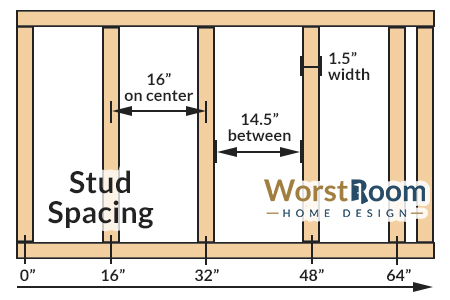
Most homes built since the latter half of the 20th century have standardized stud spacing—16 inches on-center. On-center spacing means measuring from the center of each stud. That differs from measurements that begin at the edge of the stud.
In older homes, studs can be as far apart as 24 inches on-center. Older homes didn’t have standardized building guides, so individual builders often used their methods. Most of the time, builders use the same spacing method throughout the house. If you find that your living room has studs spaced 20 inches apart, it’s likely your entire house has 20-inch spacing.
How far are studs apart? Other factors can also determine stud spacing. For example, every electrical outlet, cable connection, and light switch in your home attaches to a stud on at least one side.
Windows also require studs. Studs surround your window, framing it into place. The frame or molding that surrounds many windows attaches to the studs. Corners also require three studs attached if it’s an exterior wall, but many interior walls follow the same design.
Understanding Standard Stud Spacing in Your Home
Although most homes follow the 16-inch on-center stud spacing in walls, there are some other things you should consider when trying to find studs in your home. Here are some of the most important things to remember while looking for studs.
Interior vs. Exterior Walls
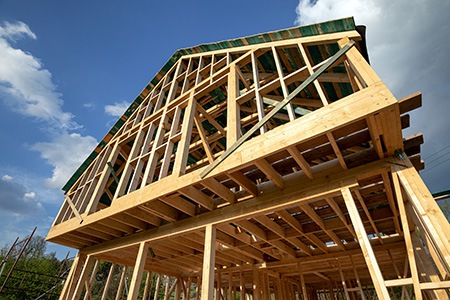
Interior walls differ from exterior types of walls because exterior walls are always structural, whereas only some interior walls add structural support. In addition, many exterior walls use 2x6 lumber. When builders use 2x6 lumber, they can change the spacing between studs.
Since 2x6 studs add more structural support than 2x4 studs, the spacing can be up to 24 inches apart on-center. When you’re looking for studs, ensure you know whether the wall is interior or exterior because it can determine how far apart the studs were built.
Stud Size
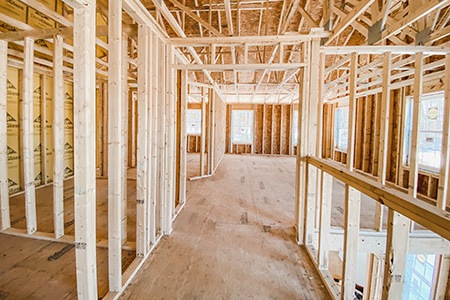
Studs most often use 2x4 lumber, although 2x6 is also common in exterior walls. 2x6s are more common in exterior walls because they allow for greater insulation and thus reduce heating or cooling costs. This width of lumber won't effect the standard stud spacing due to the 2" depth orientation remaining the same.
Interior walls almost exclusively use 2x4 studs because they’re significantly cheaper than 2x6 studs. Interior walls also don’t require insulation, so there’s no need to install wider studs.
Builders also use 2x6 lumber in certain interior circumstances. The most common instance of this is when a wall is load-bearing. Many builders choose to use 2x6 lumber for load-bearing walls because they allow for more support.
The true dimensions of 2x4 lumber are 1.5 inches thick by 3.5 inches wide. Understanding the true dimensions of lumber is essential for proper on-center spacing. It doesn't change the answer to how far apart are studs, but it changes where you'll drill or nail.
How To Find Studs With Measurements

Finding studs is often much easier than people think. If you have a stud finder, you already know how to find studs effectively. But many homeowners don’t own tools like that, so they have to rely on other methods.
Other tricks, such as guessing and driving nails into your wall, are often more work because you have to clean up the holes. Now that you know studs are generally 16 inches apart, you can use measurements to determine where the studs are in your home.
Your first step is to find a corner. Then, using a tape measure, mark 16 inches from that corner. Some people also like to mark other common distances, such as 12 and 24 inches. This won't change the distance between studs in a wall, but help you measure them from this point.
After you’ve marked where you think the stud is, use the knock test. The knock test is fairly simple, although it takes some practice. Start by knocking a few inches beside your mark. You should hear a hollow sound indicating no stud behind the drywall.
Next, knock where you made your mark. You should hear a more solid sound compared to the hollow noise from before. Before you hammer a nail or turn a screw, remember that studs require on-center spacing. That means you need to hammer in your nail on that exact mark; otherwise, you may miss your stud.
Some people like to mark 12 and 24 inches from the corner if they live in an older home or suspect that the interior walls of their home have differently spaced studs. For example, if you have a wall that’s five feet long, many builders will frame it by 12 inches because then the stud distance will be evenly distributed.
What Do Studs Do for Your Home?
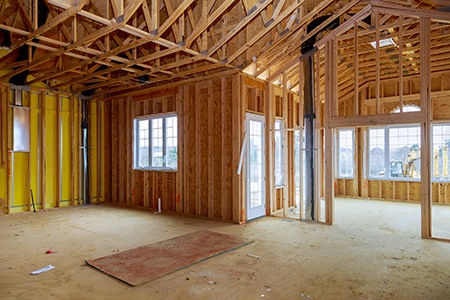
Studs perform various functions for your home apart from holding up your walls. If you’re renovating your home, adding an addition, or doing something as simple as hanging up a painting, knowing their spacing and what they do for your home is essential.
Structural Support
The most important function of studs is to support the structure of your home. Structural walls differ from non-structural walls because they’re load-bearing. All the exterior walls of your home, as well as some other interior walls, are load-bearing walls.
Load-bearing walls support different levels, other walls, and the roof. According to international standards, load-bearing walls must use 2x4 dimensional lumber spaced no more than 16 inches apart, which is the normal stud spacing regardless.
Local standards take precedence over international standards, but most local regulators derive their regulations from international codes. How far apart are studs? You can nearly always depend upon the 16 inch measurement. I've never found a scenario where it wasn't the case.
Drywall
Studs are also essential because all the types of drywall in your home attaches to the studs. Drywall retailers sell stock sheet sizes, most commonly four feet by eight feet.
One reason regulators standardized stud spacing is to ensure that drywall can easily attach to the studs. If the spacing is incorrect, drywall installers will make more mistakes due to the increased workload.
Not only does proper spacing make drywalling easier, but it can make your drywall look better. Larger spaces can cause the drywall to sag or bulge, causing your walls to look uneven and be less stable.
Outlets & Window Framing
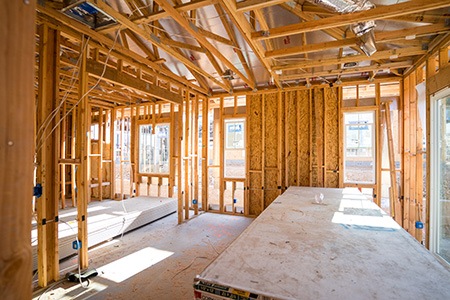
Studs are essential for electrical and other outlets because they require a stud to hold them in place. At least one side of the outlet must be attached to a stud.
Proper stud spacing allows builders and electricians to strategically place outlets in the most convenient places in your home. Conversely, if your home has improper spacing, it limits the places contractors can choose to put these outlets.
Proper stud spacing is also essential for window framing, although in different ways. Window frames require specialty spacing depending on the size of the window and the height of the window from the floor. But after the window studs and headers, each stud placed after must be placed the standard 16 inches apart.
Hanging Art or Decorations
Understanding the spacing between studs helps you hang art, mirrors, or anything else. Heavy decorations such as mirrors or shelving require studs so the nails or screws can properly support the item’s weight.
Not knowing the spacing between studs will cause you to guess where the studs are within your wall. If you’re not lucky, you’ll end up with holes that you’ll need to spend more time filling and finishing.
How Many Inches Apart are Studs?
So, how many inches apart are studs? Studs are generally 16 inches apart in modern homes. That can change for exterior walls, which sometimes use different lumber that allows for greater spacing. Older homes that didn’t use modern safety standards can also have different spacing.
Knowing how far apart are studs are essential to know because studs are structural supports that are useful in everything from placing drywall to hanging pictures. Knowing where they are in your home can save you a headache if you ever need to access them.



